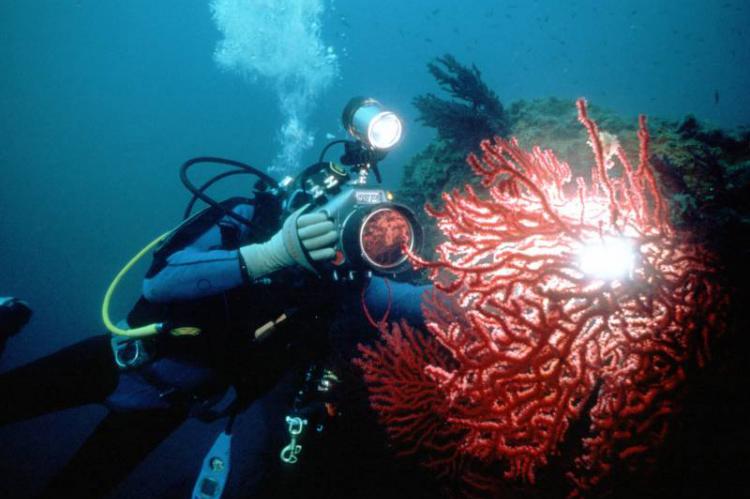Flash Photography
Getting an underwater camera is really only half the solution. Without a proper light source the possibilities will be very limited. Having one or more strobes are essential, but how to chose the right unit?
Tags & Taxonomy
First of all, the strobes—or flash units—need to be both neutrally buoyant and in balance. It is no good if one end is positively buoyant and the other negative. A neutral and balanced strobe ensures that the photographer can work in any position or situation and not get exhausted from supporting or directing the strobes even after the typical ten minute hover to get that elusive shot.
Needless to say, the cameras, too, need to be perfectly buoyant and balanced, and they usually are. But it is to no avail if fitting the strobe to the camera doesn’t balance either.
Another feature to consider is the size of the unit. Yes, size does matter but here the rule is: The smaller, the better. When shooting wide-angle, it is customary to position two strobes on each side on long extension arms. Carrying bulky units in this position can cause a lot of drag pushing them through the water and any current will soon enough turn a swim with that setup into a fitness exercise.
Many divers put too much emphasis on power and output (as defined by a guide number). But with mixed–light wideangle photography a strobe with a modest guide number of eight will actually suffice. And for extreme close-up macro-photography, space is often limited unless the subject sits right out in the open. While macro often requires plenty of power, this can be achieved with two smaller units—it actually enables you to obtain a better colour reproduction.
TTL or manual exposure?
It would be silly not to use automatic strobe exposure control (TTL) for macro, close-up or with lenses covering angles up to 60°. For wider angles, especially with super wide-angle lenses, strobe exposure is influenced by a number of factors, and TTL exposure would not be appropriate. This is easily understood when looking at the way automatic strobe exposure control works.
Light emitted by the strobe is reflected by the subject and measured either in volume or speed, dependending on the TTL system built into the camera electronics. This enables the camera to control the strobe for accurately exposure. This works well when our subject is well defined in space and distance as is usually the case when working at close to medium range. However, when working with a wide-angle lens, we have a different situation.
Other than our main subject, there will be a heck of a lot of other stuff in the frame. The exposure program can’t tell whether the light it measures is being reflected off what’s important or off a part in the frame that’s unimportant but closer to the camera. Also, most the time, an open water backdrop surrounds our subjects as well. So, if the subject does not fill more than 70 percent of the frame, there will not be sufficient reflection for proper metering. Exposure errors are quite common when not bearing this in mind. For wide-angle photography, it is therefore advisable to use manual exposure taking into consideration existing light.
Mixed light photography
Often photographers forget that—thanks to the great big diving light in the sky—they have daylight at their disposal as well. We use it to show more in our pictures than the strobe can illuminate. For optimum effect, we mix the two sources of light highlighting elements in the foreground and emphasizing their colours by flash, while ambient light generates depth in the background where the strobe light can’t reach.
Amsler’s Formula
To achieve consistent results apply “Amsler’s Formula”: AS + EA (aperture as per strobe + exposure time as per available light). Any strobe, whether of the dry or wet variety, dictates a specific ...
(...)
Download the full article ⬇︎

Originally published
X-Ray Mag #18
Soccoro Island a.k.a. islas Revillagigedos. Wolfgang dances with Tiger - free diving with Tiger sharks. Manta Ray Ecology. Great White Shark diving - with no cages Science of Sound in water. Diving solo with rebreathers - safely. Mastering Strobe Photography



